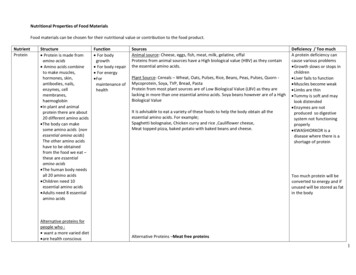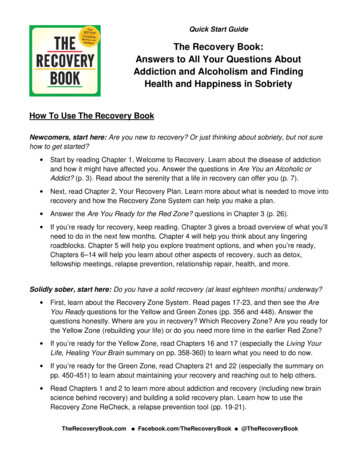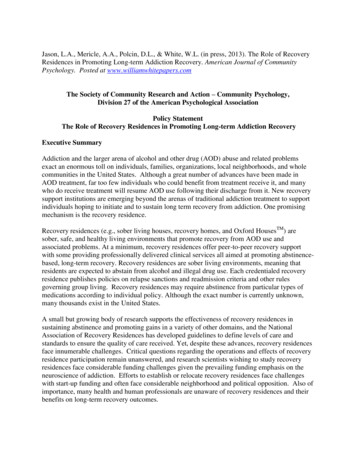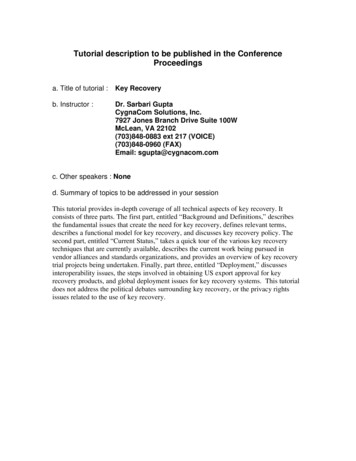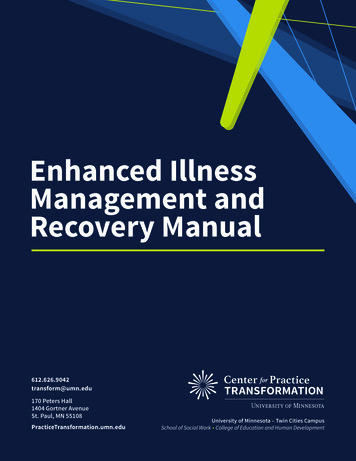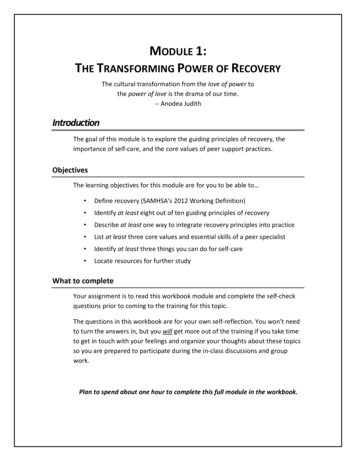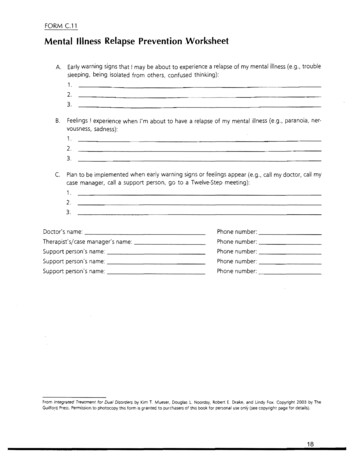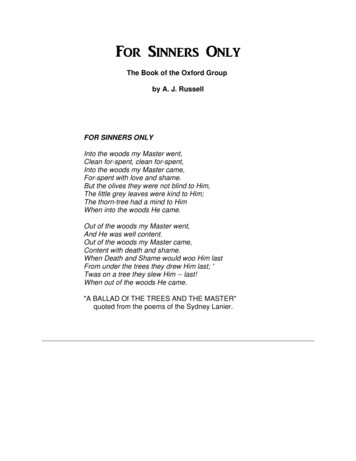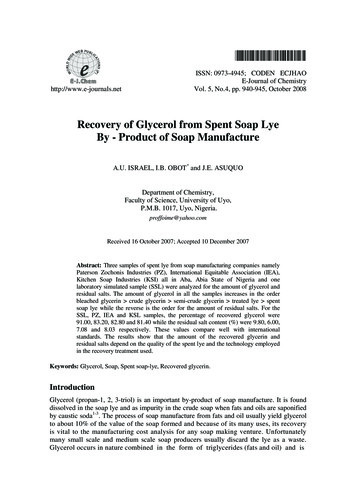
Transcription
http://www.e-journals.netISSN: 0973-4945; CODEN ECJHAOE-Journal of ChemistryVol. 5, No.4, pp. 940-945, October 2008Recovery of Glycerol from Spent Soap LyeBy - Product of Soap ManufactureA.U. ISRAEL, I.B. OBOT* and J.E. ASUQUODepartment of Chemistry,Faculty of Science, University of Uyo,P.M.B. 1017, Uyo, Nigeria.proffoime@yahoo.comReceived 16 October 2007; Accepted 10 December 2007Abstract: Three samples of spent lye from soap manufacturing companies namelyPaterson Zochonis Industries (PZ), International Equitable Association (IEA),Kitchen Soap Industries (KSI) all in Aba, Abia State of Nigeria and onelaboratory simulated sample (SSL) were analyzed for the amount of glycerol andresidual salts. The amount of glycerol in all the samples increases in the orderbleached glycerin crude glycerin semi-crude glycerin treated lye spentsoap lye while the reverse is the order for the amount of residual salts. For theSSL, PZ, IEA and KSL samples, the percentage of recovered glycerol were91.00, 83.20, 82.80 and 81.40 while the residual salt content (%) were 9.80, 6.00,7.08 and 8.03 respectively. These values compare well with internationalstandards. The results show that the amount of the recovered glycerin andresidual salts depend on the quality of the spent lye and the technology employedin the recovery treatment used.Keywords: Glycerol, Soap, Spent soap-lye, Recovered glycerin.IntroductionGlycerol (propan-1, 2, 3-triol) is an important by-product of soap manufacture. It is founddissolved in the soap lye and as impurity in the crude soap when fats and oils are saponifiedby caustic soda1-3. The process of soap manufacture from fats and oil usually yield glycerolto about 10% of the value of the soap formed and because of its many uses, its recoveryis vital to the manufacturing cost analysis for any soap making venture. Unfortunatelymany small scale and medium scale soap producers usually discard the lye as a waste.Glycerol occurs in nature combined in the form of triglycerides (fats and oil) and is
941I.B. OBOT et al.obtained during saponification of these triglycerides4. This process was the onlymeans of producing commercial glycerol until 1949 when synthetic glycerol wasproduced as the compound recovered as by-product from the soap manufacture was notsufficient for the world consumptiom. Today glycerol is synthesized from propene by thealternate chlorination and hydroxylation process5. It is also obtained from fermentation ofvarious sugars6.Some of the major industrial applications of glycerol include the manufacture of alkydresins and flexible polyurethane for the plastic industry. It is also an important ingredient incosmetics and adhesive manufacture. Many pharmaceutical preparations such as glycerolphenol mixture which serves as bacteriological culture medium and glycerol derivatives(e.g. nitro glycerol) used as tranquilizers utilize glycerol.Glycerol residue has been reported to contain 20.2% glycerol, 6.6% fatty acids (assoap) and 64.3% salt1. Thus 91.1% of it is potentially useful. It is obviously advantageous,both environmentally and economically, to recover the glycerol in the waste (spent soaplye) for use. The present work is aimed at practically exploiting these wastes materialsfrom soap industries as a potential alternative for the production of glycerol usingchemical methods.ExperimentalSpent soap lye which is a mixture of many compounds namely glycerol 6-16%, salt 10-12%,caustic soda 0.3-0.8%, total fatty matter 0.4% and water 39-40%. Others are organic andinorganic impurities such as resins, arsenic and arsenic compounds7, were obtained fromthree industries in Aba, Abia State in Nigeria. The industries include Paterson ZochonisIndustries (PZ), International Equitable Association (IEA), Kitchen Soap Industries (KSI)and the Laboratory Simulated Soap sample (SSL). Other reagents of Analytical grade fromBritish Drug House (BDH) were used as purchased in the analysis.Preparation of laboratory simulated soap sample (SSL)Palm oil (200 mL) was added to caustic soda (NaOH) slowly with constant stirring to obtaina smooth paste. The soap was grained with some quantity of brine which separated the soapmass from excess water containing glycerol, sodium hydroxide, salt and other impurities.This spent soap lye labeled sample SSL was preserved for analysis.Treatment of spent soap lyesSpent soap lyes samples (200mL) (PZ, IEA, KSI, SSL) were first analysed for percentagecaustic soda, salt, glycerol, total fatty matter, other impurities and moisture by the methodof Igile8 as described below. The left over liquor after soap manufacture (lye) was allowedto settle for 20minutes in each case after stirring with a rod. The clear phase was decantedfrom the sample and heated to 60oC in a conical flask. Acid treatment was followed byaddition of dil. HCl (0.1 M) dropwisely until the pH was between 5.0-6.0. The sample waslater filtered into a conical flask. Sodium hydroxide solution (0.1 mL) was added with theaid of a pipette to the filtrate obtained above to raise the pH again to between 8.0-9.0. Thesample was filtered again and the filtrate was analyzed for percentage caustic soda, saltand glycerol. The semi-crude glycerin was obtained by evaporating the filtrate aboveunder vacuum pressure (80 mmHg). The resultant crude glycerin was for analyzed forpercentage salt, glycerin, moisture and impurities. Salt was recovered from the crudeglycerin by allowing the sample to stand for 4h after which the clear phase was decantedfor the salt.
Recovery of Glycerol from Spent Soap Lye942Bleaching of crude glycerinThis was carried out using the method of Igile10. Crude glycerin with bleaching earth (3%)and 0.1% of H2SO4 (10 mL) were introduced into a round bottomed flask. Heat wassupplied with continuous stirring for 30minutes under vacuum (120 mmHg) and 90oC.Calcium carbonate (0.05%) was added to neutralize the content of the flask. The contentwas cooled to 70oC and filtered. This is bleached glycerin and was analysed forpercentage glycerin, salt, moisture content and impurities. Bleached glycerin was furtherpurified by vacuum distillation in order to obtain purified glycerin with highconcentration. The distillate (purified glycerin) was collected and analyzed for percentageglycerin and salt.Determination of salt content in the spent soap lyeUntreated and treated soap lye sample (0.1 g) was weighed into a conical flask (250 mL)containing distilled water (100 mL). Methyl orange indicator (2-3 drops) was added to themixture. A drop of dilute nitric acid (0.1 M) was added to neutralize the sample. This wasfollowed by the addition of potassium dichromate (2 mL) as the sample colour changed toyellow. The sample content was titrated with silver nitrate solution (0.1 M). The end pointwas detected with a colour change from yellow to light brown. From the result obtained, thepercentage salt was calculated8.Percentage free caustic soda in lye10 g of soap lye was weighed and diluted to 100mL with distilled water. Phenolphthaleinindicator (2-3) drops was added, the colour changed to pink. The same was neutralized byadding barium chloride (5 mL). The solution was titrated with hydrochloric acid (0.1 M) toobtain a colourless solution at the end point. The percentage caustic soda (NaOH) wasdetermined as volume of HCl (0.1 M) multiplied by conversion factor of 0.04%10.Percentage concentration of glycerol in crude glycerin5.0g of the sample were taken into a conical flask and 50 mL of distilled water was added. Ablank (control sample) was set up with 50 mL water at the same time. Phenol red indicator(10 drops) was added to obtain yellow colour. 0.1M HCl (1.0 mL) was added to neutralizethe contents of the flask. The sample was left to stand for 20 minutes in a dark chamber. Thesample was then titrated with 0.1 M NaOH to pink colour as the end point taking the blanksample first.The concentration of glycerol was calculated as percentage of glycerol in the crudeglycerin using the titration value according to equation (1) as reported by8.V Vb(1)C sx 0 .92aWswhere Ca is the percentage concentration of glycerol, Vs is the volume of 0.1 M NaOH addedto the sample, Vb is the volume of 0.1M NaOH added to the blank and Ws is the weight ofsample.Percentage impurities in the sample were determined by pouring the whole sample intoa measuring cylinder and allowing it to settle for 1h. The percentage impurity was calculatedfrom the equation (2) as reported by Igile8.% Impurity Level of impurity in cylinder X 100(2)Total volume of sample
943I.B. OBOT et al.Results and DiscussionTable 1 shows the estimated consumption of glycerin in various industries. Table 2 showsthe Glycerin Producers Association Standards for Glycerin recovery. Table 3 shows thepercentage concentrations of salt and glycerin and their standard deviations recovered fromSoap Lye for different samples (SSL, PZ, IEA and KSI), while Table 4 shows the standarddeviation for % salt and % glycerin for samples at different stages respectively.Table 1. Estimated consumption of glycerin in various industries11IndustryAlkyd resinTobacco hesPharmaceuticalsSealants, LubricantsVarious intermediates for syntheticdyes, Lacquers, textilesPercentage use30.0012.0012.0011.205.105.104.6020.00Table 2. Glycerin Producers Association Standards for glycerin recovery7State of Recovery% Salt% GlycerinSpent soap lye10-126-16Treated lye: Acid, (Alkaline)11-13, (16-18)5-7, (8-10)Semi-Crude Glycerin19-2230-45Crude Glycerin8-1080-84Bleached Crude Glycerin6-985-91Purified Glycerin9-1092Table 3. Percentage concentrations of salt and glycerin and their standard deviationsrecovered from soap lye for different samples (SSL, PZ, IEA and KSI)SamplesSSL% Salt% Gly.PZIEAKSI% Salt % Gly. % Salt % Gly. % Salt % Gly.Spent Soap9.3015.009.597.31 10.505.489.487.29LyeTreated Lye17.0010.009.757.95 12.906.159.047.08Semi Crude22.0040.0010.52 30.10 15.50 42.46 11.13 40.05Gly.Crude8.0081.006.40 82.80 7.4981.578.1380.40GlycerinBleached9.8091.006.00 83.20 7.0882.808.0381.40GlycerinStandard3.6637.011.67 34.28 3.2934.221.2234.78DeviationFrom Table 3, the amount of percent glycerin (%) in all the samples increases in theorder: bleached crude glycerin semi-crude glycerin spent lye treated lyerespectively, while the reverse is the order for the amount of residual salts. The percentageof glycerin recovered for the various samples- SSL, PZ, IEA and KSI were 91.00, 83.20,82.80 and 81.40 respectively. These figures compare well with the standard value obtained
Recovery of Glycerol from Spent Soap Lye944by the Glycerin Producers Association of the American Chemical Society (Table 2) in whichthe percentage recovered glycerin ranges between 85-91%. It can be seen from Table 3 thatthe amount of glycerin obtained depends on the stage of recovery. The bleaching actionyields the highest quantity of glycerin (Table 3). This is because the bleaching action(alkaline system) not only purifies the substance but also concentrates it by saponifying freetriglycerides to increase the glycerol concentration9. Thus, the amount of recovered glyceroldepends on the point of recovery and on the stages of purification8.The variation in amount of glycerin recovered from spent soap lye from the variousindustries depends on the nature of the soap lye and the method of treatment. During therecovery stages, glycerin can be lost through a number of ways such as washing, grainingand desalting. If the optimum temperature of 60oC is exceeded during treatment, sidereactions may occur. Thus glycerol may decompose to acrolein at higher temperatures asshown:H 2COHHCOHH 2COH060 CH2CCHCHO 2H2OAcroleinGlycerolOther sources of glycerin losses during the recovery operations include filtrationprocess (1%), evaporation (1%) and salt recovery (0.3%). The total loss in the recovery fromspent soap lye to pure glycerin will run to about 2.5-3.0% of glycerin in the soap lye. Thisfraction accounts for the different results obtained for percentage glycerin recovered fromthe various samples. Table 3 also shows that the amount of residual salts recovered for thesamples: SSL, PZ, IEA and KSI were 9.80, 6.00, 7.08 and 8.03 respectively. Again thequantities of residual salts depend on the point of recovery and the nature of lye treatment.The acid and alkaline treatments of the soap lye in adjusting the pH of the lye helps toreduce the amount of salt originally combined with the soap by precipitation, coagulationand flocculation10.Table 4. Standard deviation for % salt and % glycerin for samples at different stagesstages of recoverySpent Soap Lye% Salt% Gly.Treated Lye% Salt% Gly.Semi Crude Gly. % Salt% Gly.Crude Glycerin % Salt% Gly.Bleached Gly.% Salt% .00SamplesPZIEA9.59 10.507.315.489.75 12.907.956.1510.52 15.5030.10 42.466.407.4987.80 81.576.007.0883.20 41.383.75The Standard Deviation (S.D) values for glycerin recovered from spent soap lye fromvarious samples are presented in Table 4. Table 4 also shows Standard Deviation (S.D)
945I.B. OBOT et al.values for percentage (%) salt and percentage (%) glycerin for sample at different stages ofrecovery. The Standard Deviation (S.D) value which is precision index is greater than zerowhich indicates that little or negligible experimental errors were made or observed in theexperiments whereas Standard Deviation of zero indicates absolute precision. The (S.D) valueshowever, were in order considering at least three or triplicate determinations were made for eachsample. Thus, it should be noted that the reliability of any calculated quantity depends on thereliability of the data that went into the calculation and on the number of measurements made1.ConclusionThis study shows that treatment and quality of spent soap lye affect the quality and quantityof glycerin from the soap lye. With the high demand for glycerin in various industries,optimum method should be adopted in the recovery of glycerin. The spent soap lye shouldpass through all the processes of purification in order to obtain high quality glycerol yieldduring the recovery process. Glycerin should be removed from the soap lye because if left inthe soap it will limit the washing qualities of the soap. In this way, glycerol is produced forother industrial applications while the properties of soap are enhanced by absence ofglycerol. The recovered salt is reused in the soap graining operations. Therefore glycerolrecovery from spent soap lye is of economic importance to both the soap manufacturers andconsumers as well.AcknowledgementThe authors wish to thank the management of Paterson Zochonics Plc (PZ), Aba, Abia State,Nigeria for helping in some of the analysis with the help of Mrs. Uchenna Stephanie ofChemistry Department, University of Uyo, Akwa Ibom State, Nigeria.References1.2.3.4.5.6.7.8.9.10.11.Ooi T L, Yong K C, Hazimah A H, Dzulkefty K and Wan-Yunus W M Z, J OleoSci., 2004, 53, 29-33.Young F V K, J Am Oil Chem Soc., 1983, 60, 326-331Whalley G R, Happi, 1993, 6, 92-96.Parker S P, (ed.) Glycerin: Encyclopedia of Science and Technology, 6th Ed., McGraw Hill Inc., New York, 1987, 124-127.Tedder J M and Nechatal A, Basic Organic Chemistry, Part 2, Longman, London,1973, 130.Tewari K S, Mehrotra S N and Vishnoi N K, A Textbook of organic Chemistry,Vikas, New Delhi, 1980, 469.Dalton N N, Kern J C and Miner C S (Eds.), Glycerol: Encyclopedia of ChemicalTechnology, 1st Ed., Association of American Soap and Glycerin Products, U.S.A,1973, 215-229.Igile G, Manual on Glycerin Recovery, Paterson Zochonis Industries Plc, Aba,Nigeria, 1993, 3.Grant M and Hawkins R (Eds), Concise Lexion of Environmental Terms, Wiley andSons Inc., New York, 1989, 719.Igile G, Lye Treatment and Glycerin Recovery, Paterson Zochonis Industries Plc,Aba, Nigeria, 1995, 24.Henglcin F A, Chemical Technology, 1st Ed., Pergamon Press Ltd., London, 1966, 680.
International Journal ofMedicinal ChemistryHindawi Publishing Corporationhttp://www.hindawi.comVolume 2014PhotoenergyInternational Journal ofOrganic ChemistryInternationalHindawi Publishing Corporationhttp://www.hindawi.comVolume 2014Hindawi Publishing Corporationhttp://www.hindawi.comVolume 2014International Journal ofAnalytical ChemistryHindawi Publishing Corporationhttp://www.hindawi.comVolume 2014Advances inPhysical ChemistryHindawi Publishing Corporationhttp://www.hindawi.comVolume 2014International Journal ofCarbohydrateChemistryHindawi Publishing Corporationhttp://www.hindawi.comJournal ofQuantum ChemistryHindawi Publishing Corporationhttp://www.hindawi.comVolume 2014Volume 2014Submit your manuscripts athttp://www.hindawi.comJournal ofThe ScientificWorld JournalHindawi Publishing Corporationhttp://www.hindawi.comJournal ofInternational Journal ofInorganic ChemistryVolume 2014Hindawi Publishing Corporationhttp://www.hindawi.comVolume 2014Theoretical ChemistryVolume 2014CatalystsHindawi Publishing Corporationhttp://www.hindawi.comInternational Journal ofElectrochemistryHindawi Publishing Corporationhttp://www.hindawi.comVolume 2014ChromatographyResearch InternationalJournal ofJournal ofHindawi Publishing Corporationhttp://www.hindawi.comHindawi Publishing Corporationhttp://www.hindawi.comVolume 2014SpectroscopyHindawi Publishing Corporationhttp://www.hindawi.comAnalytical Methodsin ChemistryVolume 2014Hindawi Publishing Corporationhttp://www.hindawi.comVolume 2014Journal ofApplied ChemistryHindawi Publishing Corporationhttp://www.hindawi.comVolume 2014Journal ofBioinorganic Chemistryand ApplicationsHindawi Publishing Corporationhttp://www.hindawi.comVolume 2014International Journal ofChemistryHindawi Publishing Corporationhttp://www.hindawi.comVolume 2014SpectroscopyVolume 2014Hindawi Publishing Corporationhttp://www.hindawi.comVolume 2014
The process of soap manufacture from fats and oil usually yield glycerol to about 10% of the value of the soap formed and because of its many uses, its recovery is vital to the manufacturing cost analysis for any soap making venture. Unfortunately many small scale and medium scale so
